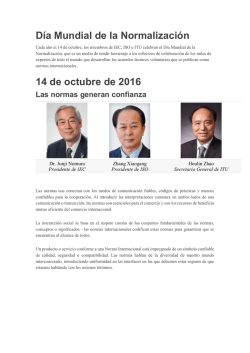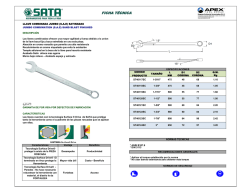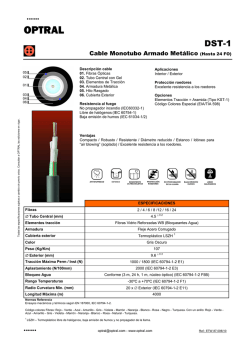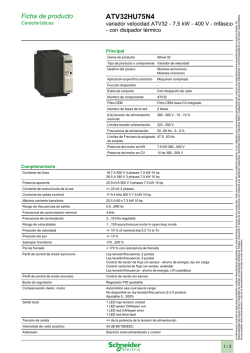
ATV71HD15M3X
ATV71HD15M3X Carácterísticas variador de velocidad ATV71 - 15 kW 20 HP - 240 V Principal Gama de producto Altivar 71 Tipo de producto o componente Variador de velocidad Aplicación específica de producto Máquinas complejas, de alta potencia Nombre de componente ATV71 Potencia del motor en kW 15 kW en 200...240 V 3 fases Potencia del motor en HP 20 hp en 200...240 V 3 fases Longitud cable de motor [Us] tensión de alimentación nominal 200...240 V (- 15...10 %) Número de fases de la red 3 fases Corriente de línea 61.6 A para 240 V 3 fases 15 kW / 20 hp 71.7 A para 200 V 3 fases 15 kW / 20 hp Filtro CEM Sin filtro CEM Estilo de conjunto Con disipación de calor Potencia aparente 25.6 kVA en 240 V 3 fases 15 kW / 20 hp Corriente de cortocircuito de la red <= 22 kA, 3 fases Corriente de salida nominal 66 A en 4 kHz 230 V 3 fases 15 kW / 20 hp Máxima corriente transitoria 109 A para 2 s 3 fases 15 kW / 20 hp 99 A para 60 s 3 fases 15 kW / 20 hp Frecuencia de salida 0.1...599 kHz Frecuencia de conmutación nominal 4 kHz Frecuencia de conmutación 1...16 kHz regulable 4...16 kHz con factor de desclasificación de la capacidad Perfil de control de motor asíncrono Sistema ENA (adaptación de energía) para cargas desequilibradas Control vector flujo (FVC) con sensores (vector actual) Control vector flujo sin sensores (SFVC) (tensión o vector actual) Ley tensión/frecuencia (2 o 5 puntos) Tipo de polarización Sin impedancia para Modbus Complementario Destino del produc Motores asíncronos Motores síncronos Límites tensión alimentación 170...264 V Frecuencia de alimentación 50...60 Hz (- 5...5 %) Frecuencia de red 47,5...63 Hz Rango de velocidades 1...100 para motor asíncrono en modo de bucle abierto, sin respuesta rápida 1...50 para motor síncrono en modo de bucle abierto, sin respuesta rápida 1...1000 para motor asíncrono modo bucle cerrado con respuesta de codificador Precisión de velocidad +/- 0,01% de veloc. nominal para 0,2 Tn a Tn variación de par modo bucle cerrado con respuesta de codificador +/-10% de deslizamiento nomin para 0,2 Tn a Tn variación de par sin respuesta de velocidad Precisión de par +/- 15 % en modo de bucle abierto, sin respuesta rápida +/- 5 % modo bucle cerrado con respuesta de codificador Sobrepar transitorio 220 % de par motor nominal +/- 10 % para 2 s 170 % de par motor nominal +/- 10 % para 60 s every 10 minutes Par de frenado <= 150 % con resistencia o resistencia de elevación 30 % sin resistencia de frenado Perfil de control de motor síncrono Contr.vec. sin respuesta veloc 1 / 10 La información incluída en esta documentación contiene descripciones generales y/o características técnicas de los productos. Esta documentación no pretende sustituir ni ser utilizada como herramienta garantizada de creación de especificaciones específicicas para usuarios finales. Es responsabilidad del usuario final o integrador de realizar un apropiado análisis de riesgos, evaluación y testeo de los productos con respecto una aplicación específica. Schneider Electric Industries SAS o cualquiera de sus empresas subsidiarias o comercializadoras no se hacen responsables de una posible mala interpretación o uso de la documentación incluída en este documento Ficha de producto Bucle de regulación Regulador PI ajustable Compensación desliz. motor Regulable Automático sea cual sea la carga No disponible en ley tensión/frecuencia (2 ó 5 puntos) Suprimible Señalizaciones en local 1 LED rojo presencia de tensión unidad Tensión de salida <= de la potencia de la tensión de alimentación Aislamien Eléctrico entre alimentación y control Tipo de cable Con un kit NEMA Tipo 1 : 3-ramal cable UG 508 en 40 °C, cobre 75 °C PVC Con un kit IP21 o IP31 : 3-ramal cable IEC en 40 °C, cobre 70 °C PVC Sin juego de montaje : 1-ramal cable IEC en 45 °C, cobre 70 °C PVC Sin juego de montaje : 1-ramal cable IEC en 45 °C, cobre 90 °C XLPE/EPR Consecutivo, seguido, continuo, adosado AI1-/AI1+, AI2, AO1, R1A, R1B, R1C, R2A, R2B, LI1...LI6, PWR Términal 2,5 mm² / AWG 14 L1/R, L2/S, L3/T, U/T1, V/T2, W/T3, PC/-, PO, PA/+, PA, PB Términal 35 mm² / AWG 2 Par de apriete AI1-/AI1+, AI2, AO1, R1A, R1B, R1C, R2A, R2B, LI1...LI6, PWR 0.6 N.m L1/R, L2/S, L3/T, U/T1, V/T2, W/T3, PC/-, PO, PA/+, PA, PB 5.4 N.m / 47,7 lb.in Suministro Alimentación interna para potenciómetro de referencia (1-10 kOhmios), 10.5 V CC +/- 5 %, <= 10 mA para protección de sobrecarga y cortocircuito Aliment. interna, 24 V CC, límites de tensión 21...27 V, <= 200 mA para protección de sobrecarga y cortocircuito Número de entrada analógica 2 Tipo de entrada análogica AI1-/Al1+ tensión diferencial bipolar +/- 10 V CC, tensión de entrada 24 V máx., resolución 11 bits + signo AI2 corriente configurable por software 0...20 mA, impedancia 242 Ohm, resolución 11 bits AI2 tensión configurable por software 0...10 V CC, tensión de entrada 24 V máx., impedancia 30000 Ohm, resolución 11 bits Duración de muestreo AI1-/Al1+ 2 ms, +/- 0,5 ms para analógica entradas Al2 2 ms, +/- 0,5 ms para analógica entradas LI1...LI5 2 ms, +/- 0,5 ms para discreta entradas LI6 (si configurado como entrada lógica) 2 ms, +/- 0,5 ms para discreta entradas Tiempo respuesta <= 100 ms en STO (torque de seguridad fuera) AO1 2 ms, tolerancia +/- 0,5 ms para analógica salidas R1A, R1B, R1C 7 ms, tolerancia +/- 0,5 ms para discreta salidas R2A, R2B 7 ms, tolerancia +/- 0,5 ms para discreta salidas Precisión AI1-/Al1+ +/- 2 % para variación temperatura 60 °C AI2 +/- 2 % para variación temperatura 60 °C AO1 +/- 1 ° para variación temperatura 60 °C Error lineal AI1-/Al1+, AI2 +/-0,15% del valor máximo AO1 +/-0.2 % Número de salida analógica 1 Tipo de salida análogica AO1 corriente configurable por software 0...20 mA, impedancia 500 Ohm, resolución 10 bits AO1 salida lógica configurable por sw 10 V <= 20 mA AO1 tensión configurable por software 0...10 V CC, impedancia 470 Ohm, resolución 10 bits Número de salida digital 2 Salida discreta R1A, R1B, R1C lógica relé configurable NA/NC, durabilidad eléctrica 100000 ciclos R2A, R2B lógica relé configurable NA, durabilidad eléctrica 100000 ciclos Corriente de conmutación mínima Lógica relé configurable 3 mA en 24 V CC Intensidad de conmutación máxima R1, R2 sobre resistivo carg, 5 A en 250 V CA, cos phi = 1, R1, R2 sobre resistivo carg, 5 A en 30 V CC, cos phi = 1, R1, R2 sobre inductivo carg, 2 A en 250 V CA, cos phi = 0,4, R1, R2 sobre inductivo carg, 2 A en 30 V CC, cos phi = 0,4, Número de entrada digital 7 Entrada discreta LI6 : switch configurable 24 V CC con PLC niv 1, impedancia: 3500 Ohm PWR : entrada seguridad 24 V CC, impedancia: 1500 Ohm de acuerdo con ISO 13849-1 nivel d LI1...LI5 : programable 24 V CC con PLC niv 1, impedancia: 3500 Ohm LI6 : sonda PTC configur. por conm. 0...6, impedancia: 1500 Ohm Entrada lógica LI1...LI5 lógica positiva (source), < 5 V (estado 0), > 11 V (estado 0) LI1...LI5 lógica negativa (sink), > 16 V (estado 0), < 10 V (estado 0) LI6 (si configurado como entrada lógica) lógica positiva (source), < 5 V (estado 0), > 11 V (estado 0) LI6 (si configurado como entrada lógica) lógica negativa (sink), > 16 V (estado 0), < 10 V (estado 0) Rampas de aceleración y deceleración Adapt. auto de rampa en caso de superar capac. de desconex. a través de resistor Acceleración ajustable por separado de 0,01 a 9000 s 2 / 10 S, U o personalizado Frenado hasta parada Mediante inyección de CC Tipo de protección Variador de velocidad contra superación veloc límit Variador de velocidad contra pérdida fase de entrada Variador de velocidad interrupc en circuito control Variador de velocidad interrupc fase entrada Variador de velocidad sobretensión en la línea de alimentación Variador de velocidad Subtensión de la línea de alimentación Variador de velocidad sobreintensidad entre fases de salida y tierra Variador de velocidad protección contra sobrecalentamiento Variador de velocidad sobretensiones en bus CC Variador de velocidad cortocircuito entre fases del motor Variador de velocidad protección térmica Motor interrup fase motor Motor Power Removal Motor protección térmica De la resistencia de aislamiento > 1 mOhm en 500 V CC para 1 minuto a tierra Resolución de frecuencia Entrada analóg. 0,024/50 Hz Unidad visualización 0.1 Hz Protocolo del puerto de comunicación CANopen Modbus Tipo de conector 1 RJ45 para Modbus en cara frontal 1 RJ45 para Modbus en terminal SUB-D 9 macho en RJ45 para CANopen Interfaz física RS 485 de dos hilos para Modbus Marco de transmisión RTU para Modbus Velocidad de transmisión 20 kbps, 50 kbps, 125 kbps, 250 kbps, 500 kbps, 1 Mbps para CANopen 4800 bps, 9600 bps, 19200 bps, 38,4 Kbps para Modbus en terminal 9600 bps, 19200 bps para Modbus en cara frontal Formato de los datos 8 bits,1 stop, paridad impar para Modbus en cara frontal 8 bits, par impar o paridad no configurable para Modbus en terminal Número de direcciones 1...247 para Modbus 1...127 para CANopen Método de acceso Esclavo para CANopen Marca CE Posición de funcionamiento Vertical +/- 10 grados Altura 400 mm Profundidad 213 mm Anchura 230 mm Peso del producto 22 kg Tarjeta opcional CC-Link tarjeta de comunicación Tarjeta programable en el interior del controlador DeviceNet tarjeta de comunicación Ethernet/IP tarjeta de comunicación Fipio tarjeta de comunicación Tarjeta extensión E/S Interbus-S tarjeta de comunicación Tarjeta de interfaz para o codificador Modbus Plus tarjeta de comunicación Modbus TCP tarjeta de comunicación Modbus/Uni-Telway tarjeta de comunicación Tarjeta grúa aérea Profibus DP tarjeta de comunicación Profibus DP V1 tarjeta de comunicación Medioambiente nivel de ruido 60.2 dB de acuerdo con 86/188/EEC fuerza dialéctrica 2830 V CC entre tierra y terminales de potencia 4230 V CC entre control y terminales de potencia compatibilidad electromagnética Prueba de inmunidad de radio frecuencia conducida de acuerdo con IEC 61000-4-6 nivel_3 Prueba de inmunidad oscilatoria/ráfagas eléctrica de acuerdo con IEC 61000-4-4 nivel_4 Prueba de inmunidad de descarga electroestática de acuerdo con IEC 61000-4-2 nivel_3 Prueba de inmunidad de la radiofrecuencia radiada del campo electromagnético de acuerdo con IEC 61000-4-3 nivel_3 Prueba de inmunidad de huecos y caídas de tensión de acuerdo con IEC 61000-4- 3 / 10 11 Prueba de inmunidad de pico de tensión 1,2/50 μs - 8/20 μs de acuerdo con IEC 61000-4-5 nivel_3 normas IEC 60721-3-3 clase 3C1 IEC 60721-3-3 clase 3S2 UL tipo 1 certificaciones CSA C-Tick GOST NOM 117 UL grado de contaminación 2 de acuerdo con EN/IEC 61800-5-1 grado de protección IP IP20 sobre la parte superior sin placa de obturación en cubierta de acuerdo con EN/IEC 60529 IP20 sobre la parte superior sin placa de obturación en cubierta de acuerdo con EN/IEC 61800-5-1 IP21 de acuerdo con EN/IEC 60529 IP21 de acuerdo con EN/IEC 61800-5-1 IP41 sobre la parte superior de acuerdo con EN/IEC 60529 IP41 sobre la parte superior de acuerdo con EN/IEC 61800-5-1 IP54 en parte inferior de acuerdo con EN/IEC 60529 IP54 en parte inferior de acuerdo con EN/IEC 61800-5-1 resistencia a las vibraciones 1,5 mm pico a pico (f = 3...13 Hz) de acuerdo con EN/IEC 60068-2-6 1 gn (f = 13...200 Hz) de acuerdo con EN/IEC 60068-2-6 resistencia a los choques 15 gn para 11 ms de acuerdo con EN/IEC 60068-2-27 humedad relativa 5...95 % sin condensación de acuerdo con IEC 60068-2-3 5...95 % sin goteo de agua de acuerdo con IEC 60068-2-3 temperatura ambiente de funcionamiento -10...50 °C sin reducir la capacidad normal temperatura ambiente de almacenamiento -25...70 °C altitud máxima de funcionamiento <= 1000 m sin reducir la capacidad normal 1000...3000 m con desclasificación de corriente del 1% por 100 m UL Type 1/IP 20 Drives Dimensions without Option Card Dimensions in mm a b c G 230 400 213 H K 210 386 Ø 8 6 Dimensions in in. a 9.05 b 15.75 c G 8.38 8.26 H 15.20 K 0.31 Ø 0.23 Dimensions with 1 Option Card (1) Dimensions in mm 4 / 10 a c1 230 236 G H 210 386 K 8 Ø 6 Dimensions in in. a c1 9.05 9.29 G H K Ø 8.26 15.20 0.31 0.23 (1) Option cards: I/O extension cards, communication cards or "Controller Inside” programmable card. Dimensions with 2 Option Cards (1) Dimensions in mm a c2 230 259 G H 210 386 K 8 Ø 6 Dimensions in in. a c2 G H K Ø 9.05 10.20 8.26 15.20 0.31 0.23 (1) Option cards: I/O extension cards, communication cards or "Controller Inside” programmable card. Mounting Recommendations Depending on the conditions in which the drive is to be used, its installation will require certain precautions and the use of appropriate accessories. Install the unit vertically: ● ● Avoid placing it close to heating elements Leave sufficient free space to ensure that the air required for cooling purposes can circulate from the bottom to the top of the unit. Clearance Mounting Types Type A Mounting Type B Mounting 5 / 10 Type C Mounting By removing the protective blanking cover from the top of the drive, the degree of protection for the drive becomes IP 20. The protective blanking cover may vary according to the drive model (refer to the user guide). The protective blanking cover must be removed from ATV 71P•••N4Z drives when they are mounted in a dust and damp proof enclosure. Specific Recommendations for Mounting the Drive in an Enclosure Ventilation To ensure proper air circulation in the drive: ● ● Fit ventilation grilles. Ensure that there is sufficient ventilation. If there is not, install a forced ventilation unit with a filter. The openings and/or fans must provide a flow rate at least equal to that of the drive fans (refer to the product characteristics). ● Use special filters with IP 54 protection. ● Remove the blanking cover from the top of the drive. Dust and Damp Proof Metal Enclosure (IP 54) The drive must be mounted in a dust and damp proof enclosure in certain environmental conditions: dust, corrosive gases, high humidity with risk of condensation and dripping water, splashing liquid, etc. This enables the drive to be used in an enclosure where the maximum internal temperature reaches 50°C. Wiring Diagram Conforming to Standards EN 954-1 Category 1, IEC/EN 61508 Capacity SIL1, in Stopping Category 0 According to IEC/EN 60204-1 Three-Phase Power Supply with Upstream Breaking via Contactor A1 ATV71 drive 6 / 10 KM1 Contactor L1 DC choke Q1 Circuit-breaker Q2 GV2 L rated at twice the nominal primary current of T1 Q3 GB2CB05 S1, XB4 B or XB5 A pushbuttons S2 T1 100 VA transformer 220 V secondary (1) Line choke (three-phase); mandatory for ATV71HC11Y…HC63Y drives (except when a special transformer is used (12-pulse)). (2) For ATV71HC40N4 drives combined with a 400 kW motor, ATV71HC50N4 and ATV71HC40Y…HC63Y, refer to the power terminal connections diagram. (3) Fault relay contacts. Used for remote signalling of the drive status. (4) Connection of the common for the logic inputs depends on the positioning of the SW1 switch. The above diagram shows the internal power supply switched to the “source” position (for other connection types, refer to the user guide). (5) There is no PO terminal on ATV71HC11Y…HC63Y drives. (6) Optional DC choke for ATV71H•••M3, ATV71HD11M3X…HD45M3X, ATV71•075N4…•D75N4 and ATV71P•••N4Z drives. Connected in place of the strap between the PO and PA/+ terminals. For ATV71HD55M3X, HD75M3X, ATV71HD90N4…HC50N4 drives, the choke is supplied with the drive; the customer is responsible for connecting it. (7) Software-configurable current (0…20 mA) or voltage (0…10 V) analog input. (8) Reference potentiometer. All terminals are located at the bottom of the drive. Fit interference suppressors on all inductive circuits near the drive or connected on the same circuit, such as relays, contactors, solenoid valves, fluorescent lighting, etc. Wiring Diagram Conforming to Standards EN 954-1 Category 1, IEC/EN 61508 Capacity SIL1, in Stopping Category 0 According to IEC/EN 60204-1 Three-Phase Power Supply with Downstream Breaking via Switch Disconnector A1 ATV71 drive L1 DC choke Q1 Circuit-breaker Q2 Switch disconnector (Vario) (1) Line choke (three-phase), mandatory for ATV71HC11Y…HC63Y drives (except when a special transformer is used (12-pulse)). (2) For ATV71HC40N4 drives combined with a 400 kW motor, ATV71HC50N4 and ATV71HC40Y…HC63Y, refer to the power terminal connections diagram. (3) Fault relay contacts. Used for remote signalling of the drive status. (4) Connection of the common for the logic inputs depends on the positioning of the SW1 switch. The above diagram shows the internal power supply switched to the “source” position (for other connection types, refer to the user guide). (5) There is no PO terminal on ATV71HC11Y…HC63Y drives. (6) Optional DC choke for ATV71H•••M3, ATV71HD11M3X…HD45M3X, ATV71•075N4…•D75N4 and ATV71P•••N4Z drives. Connected in place of the strap between the PO and PA/+ terminals. For ATV71HD55M3X, HD75M3X, ATV71HD90N4…HC50N4 drives, the choke is supplied with the drive; the customer is responsible for connecting it. (7) Software-configurable current (0…20 mA) or voltage (0…10 V) analog input. (8) Reference potentiometer. 7 / 10 All terminals are located at the bottom of the drive. Fit interference suppressors on all inductive circuits near the drive or connected on the same circuit, such as relays, contactors, solenoid valves, fluorescent lighting, etc. Wiring Diagram Conforming to Standards EN 954-1 Category 3, IEC/EN 61508 Capacity SIL2, in Stopping Category 0 According to IEC/EN 60204-1 Three-Phase Power Supply, Low Inertia Machine, Vertical Movement A1 ATV71 drive A2 Preventa XPS AC safety module for monitoring emergency stops and switches. One safety module can manage the “Power Removal” function for several drives on the same machine. In this case, each drive must connect its PWR terminal to its + 24 V via the safety contacts on the XPS AC module. These contacts are independent for each drive. F1 Fuse L1 DC choke Q1 Circuit-breaker S1 Emergency stop button with 2 contacts S2 XB4 B or XB5 A pushbutton (1) Power supply: 24 Vdc or Vac, 48 Vac, 115 Vac, 230 Vac. (2) S2: resets XPS AC module on power-up or after an emergency stop. ESC can be used to set external starting conditions. (3) Requests freewheel stopping of the movement and activates the “Power Removal” safety function. (4) Line choke (three-phase), mandatory for and ATV71HC11Y…HC63Y drives (except when a special transformer is used (12-pulse)). (5) The logic output can be used to signal that the machine is in a safe stop state. (6) For ATV71HC40N4 drives combined with a 400 kW motor, ATV71HC50N4 and ATV71HC40Y…HC63Y, refer to the power terminal connections diagram. (7) Fault relay contacts. Used for remote signalling of the drive status. (8) Connection of the common for the logic inputs depends on the positioning of the SW1 switch. The above diagram shows the internal power supply switched to the “source” position (for other connection types, refer to the user guide). (9) Standardized coaxial cable, type RG174/U according to MIL-C17 or KX3B according to NF C 93-550, external diameter 2.54 mm /0.09 in., maximum length 15 m / 49.21 ft. The cable shielding must be earthed. (10) There is no PO terminal on ATV71HC11Y…HC63Y drives. (11) Optional DC choke for ATV71H•••M3, ATV71HD11M3X…HD45M3X, ATV71•075N4…•D75N4 and ATV71P•••N4Z drives. Connected in place of the strap between the PO and PA/+ terminals. For ATV71HD55M3X, HD75M3X, ATV71HD90N4…HC50N4 drives, the choke is supplied with the drive; the customer is responsible for connecting it. (12) Software-configurable current (0…20 mA) or voltage (0…10 V) analog input. (13) Reference potentiometer. All terminals are located at the bottom of the drive. Fit interference suppressors on all inductive circuits near the drive or connected on the same circuit, such as relays, contactors, solenoid valves, fluorescent lighting, etc. Wiring Diagram Conforming to Standards EN 954-1 Category 3, IEC/EN 61508 Capacity SIL2, in Stopping Category 1 According to IEC/EN 60204-1 Three-Phase Power Supply, High Inertia Machine 8 / 10 A1 ATV71 drive A2 (5) Preventa XPS ATE safety module for monitoring emergency stops and switches. One safety module can manage the "Power Removal” safety function for several drives on the same machine. In this case the time delay must be adjusted on the drive controlling the motor that requires the longest stopping time. In addition, each drive must connect its PWR terminal to its + 24 V via the safety contacts on the XPS ATE module. These contacts are independent for each drive. F1 Fuse L1 DC choke Q1 Circuit-breaker S1 Emergency stop button with 2 N/C contacts S2 Run button (1) Power supply: 24 Vdc or Vac, 115 Vac, 230 Vac. (2) Requests controlled stopping of the movement and activates the “Power Removal” safety function. (3) Line choke (three-phase), mandatory for ATV71HC11Y…HC63Y drives (except when a special transformer is used (12-pulse)). (4) S2: resets XPS ATE module on power-up or after an emergency stop. ESC can be used to set external starting conditions. (5) For stopping times requiring more than 30 seconds in category 1, use a Preventa XPS AV safety module which can provide a maximum time delay of 300 seconds. (6) The logic output can be used to signal that the machine is in a safe state. (7) For ATV71HC40N4 drives combined with a 400 kW motor, ATV71HC50N4 and ATV71HC40Y…HC63Y, refer to the power terminal connections diagram. (8) Fault relay contacts. Used for remote signalling of the drive status. (9) Connection of the common for the logic inputs depends on the positioning of the SW1 switch. The above diagram shows the internal power supply switched to the “source” position (for other connection types, refer to the user guide). (10) Standardized coaxial cable, type RG174/U according to MIL-C17 or KX3B according to NF C 93-550, external diameter 2.54 mm/0.09 in., maximum length 15 m/49.21 ft. The cable shielding must be earthed. (11) Logic inputs LI1 and LI2 must be assigned to the direction of rotation: LI1 in the forward direction and LI2 in the reverse direction. (12) There is no PO terminal on ATV71HC11Y…HC63Y drives. (13) Optional DC choke for ATV71H•••M3, ATV71HD11M3X…HD45M3X, ATV71•075N4…•D75N4 and ATV71P•••N4Z drives. Connected in place of the strap between the PO and PA/+ terminals. For ATV71HD55M3X, HD75M3X, ATV71HD90N4…HC50N4 drives, the choke is supplied with the drive; the customer is responsible for connecting it. (14) Software-configurable current (0…20 mA) or voltage (0…10 V) analog input. (15) Reference potentiometer. All terminals are located at the bottom of the drive. Fit interference suppressors on all inductive circuits near the drive or connected on the same circuit, such as relays, contactors, solenoid valves, fluorescent lighting, etc. Derating Curves The derating curves for the drive nominal current (In) depend on the temperature, the switching frequency and the mounting type. For intermediate temperatures (e.g. 55°C), interpolate between 2 curves. 9 / 10 X Switching frequency (1) Mounting type 10 / 10
© Copyright 2025



